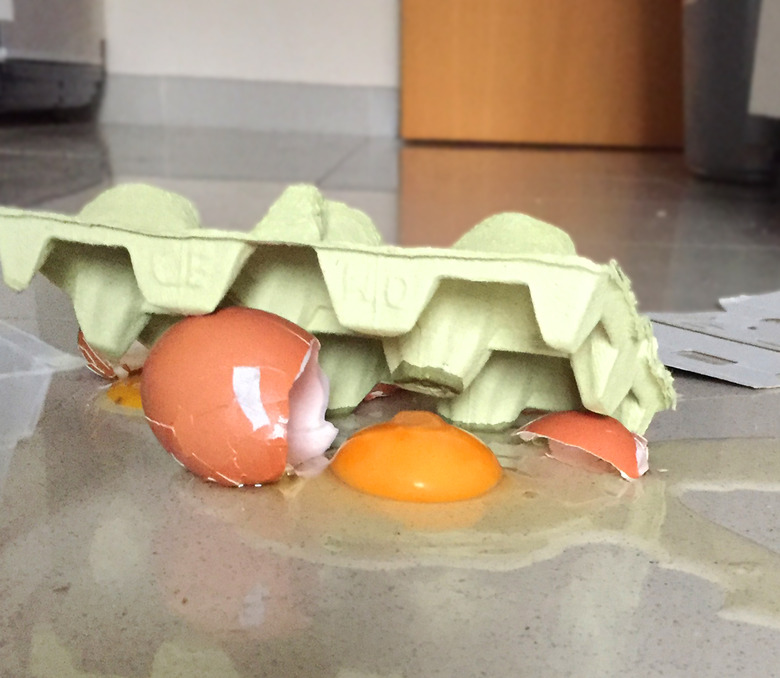How To Make An Egg Survive A 20-Foot Drop
If you've entered an egg-drop contest, there are basically two strategies you can use to help that egg survive a fall. The first is to cushion the impact, and the second is to reduce the speed of the fall. If you get to choose your own egg, you can soften it with vinegar to help it absorb the impact. That will help, but by itself, it won't prevent the egg from breaking.
Cushioning the Impact
Cushioning the Impact
Enclosing the egg in something that can absorb the force of impact can protect the egg from a fall. You'll need something that is highly compressible for this. Water won't do the trick, nor will soft solids like peanut butter or sugar, or any incompressible liquid or powder. A gas is compressible, though, and air is a gas, so anything that contains a lot of air should work. Possibilities include balloons, popcorn, packing peanuts, wads of paper or cereal puffs. Encase the egg in any of these inside a paper or plastic bag, a sock or a stocking. If you have any bubble wrap around the house, wrapping the egg in several layers of bubble wrap should also provide a good cushion.
Slowing the Fall
Slowing the Fall
Slowing the egg's fall is key for keeping the egg in one piece, but slowing does not take the place of protecting. Parachutes, for example, make things fall more slowly, but if you've ever seen a parachutist land, you'll know that the impact can still be jarring – jarring enough to break an egg. This means that, if you create a parachute for the egg, you still need to protect the egg. You can also try tying several balloons to your egg before dropping it instead of building a parachute; they should slow the egg's descent. Aerodynamic rotors, such as those on a propeller beanie, can also work. The weight of the egg actually makes the rotors spin faster to slow its fall. If you make the rotors just the right size, the egg may fall slowly enough to survive, even without added protection.
Combining the Strategies
Combining the Strategies
The egg is almost sure to survive if you cushion it appropriately and slow its fall enough at the same time. It's possible to do this in many ways, and it may take some creativity to find the best way based on your resources. Some competitions limit the materials you can use, and it also takes creativity to work within those requirements.
Things Needed
- Container
- Air-filled cushioning material
- Several balloons
- Cloth or parchment paper
- Rotor
- String
- Duct tape
- 14-gauge wire
1. Protect the Egg
Find a suitable container, such as a plastic food container, a stocking, a plastic zip-lock bag or a padded envelope. Fill the container with packing peanuts, popcorn, cereal puffs or some other material that contains lots of air. Don't forget to leave room for the egg. Place the egg inside, ensuring it's surrounded by the cushioning material, and close the container.
2. Make It Float Instead of Fall
Attach something to the container to make it fall more slowly. Possibilities include:
- Several medium-size balloons.
- A makeshift parachute made from lightweight cloth or parchment paper.
- The rotor from a helicopter beanie.
You can tie whatever it is you use to the container or affix it with duct tape. If you decide to use a rotor, it's best to connect it with 14-gauge wire. Pass the wire through the center of the rotor and bend it back on itself to keep the rotor secure while still allowing it to spin. Tape the other end of the wire to your container.
TL;DR (Too Long; Didn't Read)
An eggshell contains calcium carbonate, which is hard but brittle. According to Juan Silva, a food science professor at the University of Mississippi, vinegar dissolves the calcium carbonate and makes the shell less breakable. By the way, soaking an egg overnight in vinegar can not only help it survive a fall, but it also makes an egg easier to peel after boiling it.
Cite This Article
MLA
Deziel, Chris. "How To Make An Egg Survive A 20-Foot Drop" sciencing.com, https://www.sciencing.com/make-egg-survive-20foot-drop-8293632/. 13 March 2018.
APA
Deziel, Chris. (2018, March 13). How To Make An Egg Survive A 20-Foot Drop. sciencing.com. Retrieved from https://www.sciencing.com/make-egg-survive-20foot-drop-8293632/
Chicago
Deziel, Chris. How To Make An Egg Survive A 20-Foot Drop last modified March 24, 2022. https://www.sciencing.com/make-egg-survive-20foot-drop-8293632/
